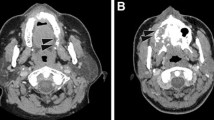Abstract
Purpose
Rhabdomyosarcoma (RMS) is a malignant tumor frequent in children. The frequency and characteristics of cranial nerve involvement in pediatric head and neck (H&N) RMS have been scarcely reported. The aim of this study is to review a large cohort of pediatric head and neck RMS with an emphasis on cranial nerve involvement.
Methods
We retrospectively reviewed H&N RMS cases from 3 tertiary hospitals over a 10-year period. Cranial nerve involvement was defined as radiologically apparent tumor extension along a nerve and/or the presence of secondary signs. Scans were reviewed by two pediatric neuroradiologists, blinded to clinical data.
Results
A total of 52 patients met the inclusion criteria. Histologically, 39/52 were embryonal RMS, while 13/52 were alveolar RMS. Regional lymph nodes metastases were present in 19.2%. Cranial nerve involvement was present in 36.5%. Nerves were mainly involved as a direct extension of the mass through skull base foramina or after invasion of cavernous sinus, Meckel’s cave, orbital apex, or stylomastoid foramen.
Conclusion
Cranial nerve involvement is frequent in pediatric head and neck RMS and occurs secondary to “geographic” invasion due to direct extension through skull base foramina or cavernous sinus. These tumors never showed distant perineural metastatic disease as is seen in cases of adult head and neck carcinomas. This implies a different biological interaction between the nerves and these tumors in comparison to adult H&N tumors.


Similar content being viewed by others
Change history
06 September 2021
A Correction to this paper has been published: https://doi.org/10.1007/s00234-021-02797-6
Abbreviations
- ADC:
-
Apparent diffusion coefficient
- aRMS:
-
Alveolar rhabdomyosarcoma
- DWI:
-
Diffusion-weighted imaging
- eRMS:
-
Embryonal rhabdomyosarcoma
- H&N:
-
Head and neck
- RMS:
-
Rhabdomyosarcoma
References
Jawad N, McHugh K (2019) The clinical and radiologic features of paediatric rhabdomyosarcoma. Pediatr Radiol 4911:1516–1523
Freling NJM, Merks JHM, Saeed P et al (2010) Imaging findings in craniofacial childhood rhabdomyosarcoma. Pediatr Radiol 4011:1723–38; quiz 1855
Dankbaar JW, Pameijer FA, Hendrikse J et al (2018) Easily detected signs of perineural tumour spread in head and neck cancer. Insights Imaging 96:1089–1095
Bakst RL, Glastonbury CM, Parvathaneni U et al (2019) Perineural invasion and perineural tumor spread in head and neck cancer. Int J Radiat Oncol Biol Phys 1035:1109–1124
Curtin HD (1998) Detection of perineural spread: fat is a friend. AJNR Am J Neuroradiol 198:1385–1386
Zorzi AP, Grant R, Gupta AA et al (2012) Cranial nerve palsies in childhood parameningeal rhabdomyosarcoma. Pediatr Blood Cancer 597:1211–1214
Caldemeyer KS, Mathews VP, Righi PD et al (1998) Imaging features and clinical significance of perineural spread or extension of head and neck tumors. Radiographics 181:97–110; quiz 147
Lope LA, Hutcheson KA, Khademian ZP (2010) Magnetic resonance imaging in the analysis of pediatric orbital tumors: utility of diffusion-weighted imaging. J AAPOS 143:257–262
Ishikawa M, Anzai Y (2004) MR imaging of lymph nodes in the head and neck. Neuroimaging Clin N Am 144:679–694
Lee JH, Lee MS, Lee BH et al (1996) Rhabdomyosarcoma of the head and neck in adults: MR and CT findings. AJNR Am J Neuroradiol 1710:1923–1928
Yousem DM, Lexa FJ, Bilaniuk LT et al (1990) Rhabdomyosarcomas in the head and neck: MR imaging evaluation. Radiology 1773:683–686
King AD, Ahuja AT, Yeung DKW et al (2007) Malignant cervical lymphadenopathy: diagnostic accuracy of diffusion-weighted MR imaging. Radiology 2453:806–813
Vandecaveye V, De Keyzer F, Vander Poorten V et al (2009) Head and neck squamous cell carcinoma: value of diffusion-weighted MR imaging for nodal staging. Radiology 2511:134–146
Scelsi CL, Wang A, Garvin CM et al (2019) Head and neck sarcomas: a review of clinical and imaging findings based on the 2013 World Health Organization classification. AJR Am J Roentgenol 2123:644–654
Dombrowski ND, Wolter NE, Robson CD et al (2021) Role of surgery in rhabdomyosarcoma of the head and neck in children. Laryngoscope 131(3):E984–E992. https://doi.org/10.1002/lary.28785
Mullaney PB, Nabi NU, Thorner P et al (2001) Ophthalmic involvement as a presenting feature of nonorbital childhood parameningeal embryonal rhabdomyosarcoma. Ophthalmology 1081:179–182
Chen S-H, Zhang B-Y, Zhou B et al (2019) Perineural invasion of cancer: a complex crosstalk between cells and molecules in the perineural niche. Am J Cancer Res 91:1–21
Batsakis JG (1985) Nerves and neurotropic carcinomas. Ann Otol Rhinol Laryngol 944(Pt 1):426–427
Liebig C, Ayala G, Wilks JA et al (2009) Perineural invasion in cancer: a review of the literature. Cancer 11515:3379–3391
Borges A, Casselman J (2007) Imaging the cranial nerves: part II: primary and secondary neoplastic conditions and neurovascular conflicts. Eur Radiol 179:2332–2344
Funding
This work was supported by the National Institute for Health Research, Great Ormond Street Hospital Biomedical Research Centre.
Author information
Authors and Affiliations
Corresponding author
Ethics declarations
Conflict of interest
The authors declare that they have no conflict of interest.
Ethical approval
No research involving humans or animals was conducted.
Informed consent
No informed consent is needed for retrospective papers.
Additional information
Publisher's note
Springer Nature remains neutral with regard to jurisdictional claims in published maps and institutional affiliations.
The original online version of this article was revised: Originally, the article has been published online with inverted author names. This has been corrected above.
Rights and permissions
About this article
Cite this article
Talenti, G., Picariello, S., Robson, C. et al. Magnetic resonance features and cranial nerve involvement in pediatric head and neck rhabdomyosarcomas. Neuroradiology 63, 1925–1934 (2021). https://doi.org/10.1007/s00234-021-02765-0
Received:
Accepted:
Published:
Issue Date:
DOI: https://doi.org/10.1007/s00234-021-02765-0




